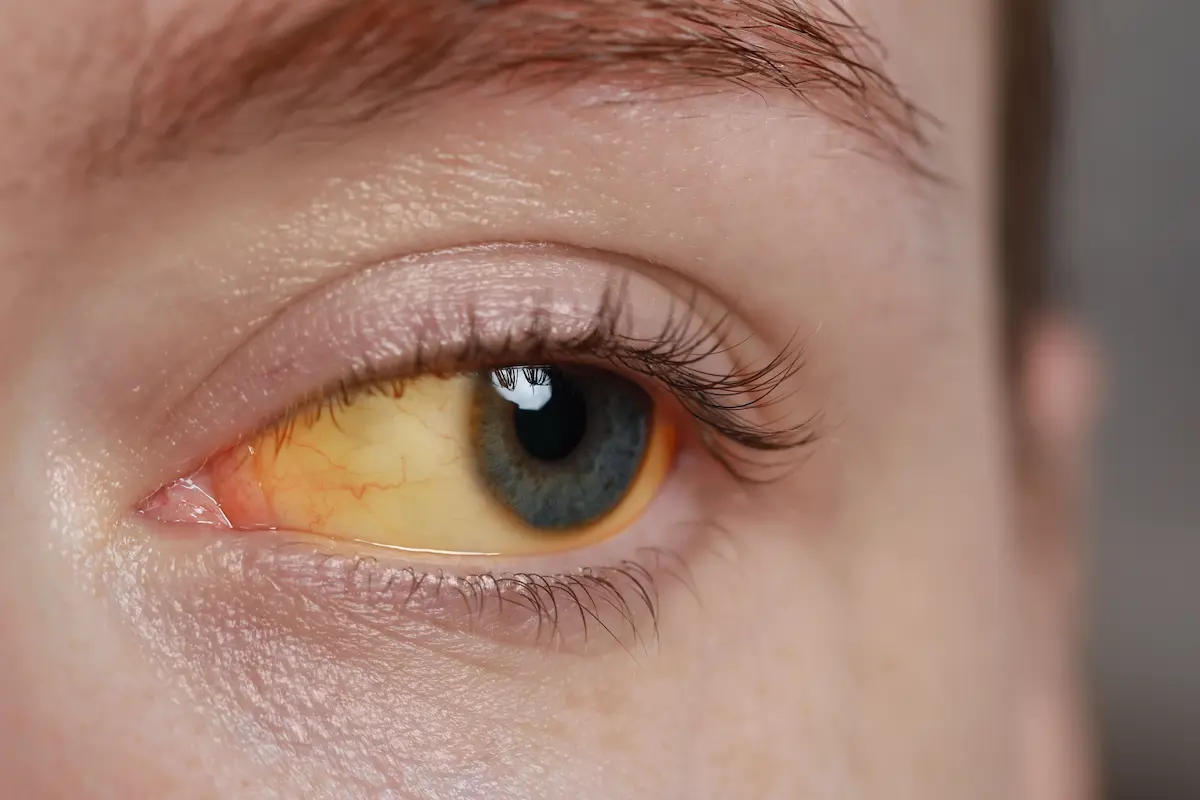What Is Scleral Icterus? Warning Signs Behind Yellow Eyes

Have you noticed a yellow tint in the whites of your eyes? This condition is known as scleral icterus — a sign that your body may be dealing with an underlying issue involving the liver, gallbladder, or blood. But what exactly is scleral icterus, and how is it different from jaundice?
In this guide, we’ll explain what scleral icterus looks like, the causes of scleral icterus, and how to differentiate it from general jaundice. We’ll also walk you through the importance of early detection and when to see a primary doctor in Miami for evaluation and treatment.
What Is Scleral Icterus?
Scleral icterus refers specifically to the yellow discoloration of the sclera — the white part of the eyes — due to elevated levels of bilirubin in the blood. Bilirubin is a yellowish pigment created during the normal breakdown of red blood cells. When it’s not properly processed by the liver or bile ducts, it can accumulate in the body and become visible in the eyes.
This yellowing is often one of the first visible signs of a deeper problem, such as liver disease or hemolytic anemia. While it can appear subtle at first, any degree of scleral yellowing should be taken seriously.
Scleral Icterus vs Jaundice: What’s the Difference?
It’s easy to confuse scleral icterus vs jaundice, but they’re not exactly the same thing.
- Scleral icterus: Yellowing limited to the eyes.
- Jaundice: Yellowing of the skin, mucous membranes, and eyes — a broader systemic sign.
In many cases, scleral icterus is simply an early phase or localized expression of jaundice. Once bilirubin levels rise further, skin discoloration usually follows. Detecting scleral icterus early can lead to faster diagnosis of serious underlying conditions.

Causes of Scleral Icterus
Several conditions can cause a buildup of bilirubin, leading to scleral icterus. These may be related to liver function, red blood cell breakdown, or bile duct obstruction.
Common causes of scleral icterus include:
- Liver diseases
- Hepatitis (viral, autoimmune, alcoholic)
- Cirrhosis
- Fatty liver disease (NAFLD)
- Liver cancer
- Bile duct obstruction
- Gallstones blocking bile flow
- Pancreatic tumors
- Biliary atresia (in infants)
- Hemolytic anemia
- Rapid breakdown of red blood cells
- Genetic conditions like sickle cell anemia or thalassemia
- Gilbert’s syndrome
- A mild genetic disorder affecting bilirubin processing
- Medication side effects
- Certain antibiotics, acetaminophen overuse, or chemotherapy drugs
In all these cases, the underlying issue must be treated to resolve the yellowing of the eyes.
When to See a Primary Doctor in Miami
If you notice even slight yellowing in your eyes or other symptoms like fatigue, dark urine, or abdominal pain, it’s time to speak with a healthcare provider.
A primary doctor in Miami can:
- Perform a physical exam focused on your liver and eyes
- Order a comprehensive metabolic panel and bilirubin blood test
- Check liver enzymes, complete blood count, and clotting factors
- Refer you for imaging like an ultrasound or CT scan
- Identify whether your symptoms are related to liver, bile duct, or red blood cell disorders
Prompt testing and diagnosis are key to preventing complications, especially if your condition is related to liver damage or biliary obstruction.
Related Symptoms to Watch For
In addition to yellowing of the eyes, icteric patients (those showing signs of jaundice) may experience a range of symptoms depending on the cause:
- Dark urine
Due to excess bilirubin being excreted through the kidneys - Pale stools
A sign of blocked bile flow to the intestines - Itchy skin
Accumulation of bile salts in the bloodstream - Fatigue or weakness
Often seen in chronic liver conditions or anemia - Abdominal discomfort
Especially in the right upper quadrant, possibly signaling liver or gallbladder involvement
If you notice any of these symptoms in addition to scleral icterus, seek medical attention promptly.
How Is Scleral Icterus Treated?
Treatment depends entirely on the underlying cause. Your doctor’s goal will be to identify and resolve the source of bilirubin buildup.
Examples of treatment approaches:
- Hepatitis: Antiviral or steroid therapy
- Gallstones: Removal via ERCP or gallbladder surgery
- Hemolytic anemia: Medication, blood transfusions, or addressing triggers
- Liver damage: Lifestyle changes, medication, or referral to a hepatologist
In mild cases, especially those related to Gilbert’s syndrome or temporary illness, the condition may resolve on its own once bilirubin levels stabilize.
Final Thoughts: What Is Scleral Icterus and Why You Shouldn’t Ignore It
Scleral icterus is more than a cosmetic concern — it’s a visible indicator of a potentially serious internal issue involving your liver, red blood cells, or bile ducts. Understanding the causes of scleral icterus and how it differs from full-body jaundice can help you take proactive steps toward diagnosis and recovery.
If you notice any yellowing in your eyes, don’t wait. Schedule a visit with our primary doctor in Miami for a full evaluation, lab testing, and personalized care. The sooner you act, the better the chances of addressing the root cause and avoiding further complications.
Frequently Asked Questions (FAQs)
- What is scleral icterus?
Scleral icterus is the yellow discoloration of the whites of the eyes caused by elevated bilirubin levels in the blood.
- What causes scleral icterus?
It can be caused by liver disease, gallbladder obstruction, hemolytic anemia, or genetic conditions like Gilbert’s syndrome.
- Is scleral icterus the same as jaundice?
Not exactly. Scleral icterus refers specifically to yellowing in the eyes, while jaundice affects the eyes, skin, and mucous membranes.
- When should I see a doctor about scleral icterus?
If you notice yellowing in your eyes or symptoms like fatigue, dark urine, or abdominal pain, see a primary doctor in Miami immediately.
- How is scleral icterus treated? Treatment depends on the cause and may include medication, dietary changes, or procedures to remove bile duct obstructions.
Contact Us
Hiriart & Lopez MD, LLC
9950 SW 107th Ave STE 101,
Miami, FL 33176
305-274-8779
Phone: (305) 274-8779
Fax: (305) 274-0646
OPENING HOURS
Monday 7:30 AM–4:30 PM
Tuesday 7:30 AM–4:30 PM
Wednesday 7:30 AM–4:30 PM
Thursday 7:30 AM–4:30 PM
Friday 7:30–11 AM
Saturday Closed
Sunday Closed
OFFICE LOCATION
What Is Scleral Icterus? Warning Signs Behind Yellow Eyes

Have you noticed a yellow tint in the whites of your eyes? This condition is known as scleral icterus — a sign that your body may be dealing with an underlying issue involving the liver, gallbladder, or blood. But what exactly is scleral icterus, and how is it different from jaundice?
In this guide, we’ll explain what scleral icterus looks like, the causes of scleral icterus, and how to differentiate it from general jaundice. We’ll also walk you through the importance of early detection and when to see a primary doctor in Miami for evaluation and treatment.
What Is Scleral Icterus?
Scleral icterus refers specifically to the yellow discoloration of the sclera — the white part of the eyes — due to elevated levels of bilirubin in the blood. Bilirubin is a yellowish pigment created during the normal breakdown of red blood cells. When it’s not properly processed by the liver or bile ducts, it can accumulate in the body and become visible in the eyes.
This yellowing is often one of the first visible signs of a deeper problem, such as liver disease or hemolytic anemia. While it can appear subtle at first, any degree of scleral yellowing should be taken seriously.
Scleral Icterus vs Jaundice: What’s the Difference?
It’s easy to confuse scleral icterus vs jaundice, but they’re not exactly the same thing.
- Scleral icterus: Yellowing limited to the eyes.
- Jaundice: Yellowing of the skin, mucous membranes, and eyes — a broader systemic sign.
In many cases, scleral icterus is simply an early phase or localized expression of jaundice. Once bilirubin levels rise further, skin discoloration usually follows. Detecting scleral icterus early can lead to faster diagnosis of serious underlying conditions.

Causes of Scleral Icterus
Several conditions can cause a buildup of bilirubin, leading to scleral icterus. These may be related to liver function, red blood cell breakdown, or bile duct obstruction.
Common causes of scleral icterus include:
- Liver diseases
- Hepatitis (viral, autoimmune, alcoholic)
- Cirrhosis
- Fatty liver disease (NAFLD)
- Liver cancer
- Bile duct obstruction
- Gallstones blocking bile flow
- Pancreatic tumors
- Biliary atresia (in infants)
- Hemolytic anemia
- Rapid breakdown of red blood cells
- Genetic conditions like sickle cell anemia or thalassemia
- Gilbert’s syndrome
- A mild genetic disorder affecting bilirubin processing
- Medication side effects
- Certain antibiotics, acetaminophen overuse, or chemotherapy drugs
In all these cases, the underlying issue must be treated to resolve the yellowing of the eyes.
When to See a Primary Doctor in Miami
If you notice even slight yellowing in your eyes or other symptoms like fatigue, dark urine, or abdominal pain, it’s time to speak with a healthcare provider.
A primary doctor in Miami can:
- Perform a physical exam focused on your liver and eyes
- Order a comprehensive metabolic panel and bilirubin blood test
- Check liver enzymes, complete blood count, and clotting factors
- Refer you for imaging like an ultrasound or CT scan
- Identify whether your symptoms are related to liver, bile duct, or red blood cell disorders
Prompt testing and diagnosis are key to preventing complications, especially if your condition is related to liver damage or biliary obstruction.
Related Symptoms to Watch For
In addition to yellowing of the eyes, icteric patients (those showing signs of jaundice) may experience a range of symptoms depending on the cause:
- Dark urine
Due to excess bilirubin being excreted through the kidneys - Pale stools
A sign of blocked bile flow to the intestines - Itchy skin
Accumulation of bile salts in the bloodstream - Fatigue or weakness
Often seen in chronic liver conditions or anemia - Abdominal discomfort
Especially in the right upper quadrant, possibly signaling liver or gallbladder involvement
If you notice any of these symptoms in addition to scleral icterus, seek medical attention promptly.
How Is Scleral Icterus Treated?
Treatment depends entirely on the underlying cause. Your doctor’s goal will be to identify and resolve the source of bilirubin buildup.
Examples of treatment approaches:
- Hepatitis: Antiviral or steroid therapy
- Gallstones: Removal via ERCP or gallbladder surgery
- Hemolytic anemia: Medication, blood transfusions, or addressing triggers
- Liver damage: Lifestyle changes, medication, or referral to a hepatologist
In mild cases, especially those related to Gilbert’s syndrome or temporary illness, the condition may resolve on its own once bilirubin levels stabilize.
Final Thoughts: What Is Scleral Icterus and Why You Shouldn’t Ignore It
Scleral icterus is more than a cosmetic concern — it’s a visible indicator of a potentially serious internal issue involving your liver, red blood cells, or bile ducts. Understanding the causes of scleral icterus and how it differs from full-body jaundice can help you take proactive steps toward diagnosis and recovery.
If you notice any yellowing in your eyes, don’t wait. Schedule a visit with our primary doctor in Miami for a full evaluation, lab testing, and personalized care. The sooner you act, the better the chances of addressing the root cause and avoiding further complications.
Frequently Asked Questions (FAQs)
- What is scleral icterus?
Scleral icterus is the yellow discoloration of the whites of the eyes caused by elevated bilirubin levels in the blood.
- What causes scleral icterus?
It can be caused by liver disease, gallbladder obstruction, hemolytic anemia, or genetic conditions like Gilbert’s syndrome.
- Is scleral icterus the same as jaundice?
Not exactly. Scleral icterus refers specifically to yellowing in the eyes, while jaundice affects the eyes, skin, and mucous membranes.
- When should I see a doctor about scleral icterus?
If you notice yellowing in your eyes or symptoms like fatigue, dark urine, or abdominal pain, see a primary doctor in Miami immediately.
- How is scleral icterus treated? Treatment depends on the cause and may include medication, dietary changes, or procedures to remove bile duct obstructions.
Contact Us
Hiriart & Lopez MD, LLC
9950 SW 107th Ave STE 101,
Miami, FL 33176
305-274-8779
Phone: (305) 274-8779
Fax: (305) 274-0646
OPENING HOURS
Monday 7:30 AM–4:30 PM
Tuesday 7:30 AM–4:30 PM
Wednesday 7:30 AM–4:30 PM
Thursday 7:30 AM–4:30 PM
Friday 7:30–11 AM
Saturday Closed
Sunday Closed

